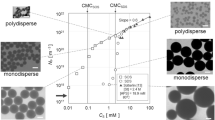Abstract
The soap-free emulsion copolymerization of styrene and methyl methacrylate (MMA) monomers using a water- or oil-soluble initiator was carried out at a constant monomer concentration to synthesize polymeric particles. The relationship between particle size and surface potential was investigated by changing the mixing ratio of MMA to styrene during the copolymerization. Both the particle sizes and zeta potentials were nearly constant when using water-soluble initiator, V-50, because the decomposition of the functional groups of the water-soluble initiator had a large influence on the surface potential. On the other hand, on increasing the molar fraction of MMA monomers, the surface potential of the particles formed during the copolymerization with an oil-soluble initiator, 2,2′-azobis(2-methylpropionitrile), decreased and the particle size increased due to coagulation between particles. This occurred because the surface potential is controlled by the presence of phenyl rings in the styrene monomer. We concluded that both particle size and surface potential can be controlled by adjusting the monomer mixture ratio in the soap-free emulsion copolymerization using an oil-soluble initiator.





Similar content being viewed by others
References
Zhu S, Tian Y, Hamielec AE, Eaton DR (1990) Radical concentrations in free radical copolymerization of MMA/EGDMA. Polymer 31:154–159
Li P, Zhu JM, Sunintaboon P, Harris FW (2002) New route to amphiphilic core-shell polymer nanospheres: graft copolymerization of methyl methacrylate from water-soluble polymer chains containing amino groups. Langmuir 18:8641–8646
Ishizu K, Tahara N (1996) Microsphere synthesis by emulsion copolymerization of methyl methacrylate with poly(methacrylic acid) macromonomers. Polymer 37:2853–2856
Kai Kang CYK, Yi D, Liu DS (2004) Control of particle size and carboxyl group distribution in soap-free emulsion copolymerization of methyl methacrylate–ethyl acrylate–acrylic acid. J Appl Polym Sci 92:433–438
Zhang JZ, Zou QC, Li XQ, Cheng SY (2003) Soap-free cationic emulsion copolymerization of styrene and butyl acrylate with comonomer in the presence of alcohols. J Appl Polym Sci 89:2791–2797
Suzuki D, Kawaguchi H (2006) Stimuli-sensitive core/shell template particles for immobilizing inorganic nanoparticles in the core. Colloid Polym Sci 284:1443–1451
Goodall AR, Wilkinson MC, Hearn J (1977) Mechanism of emulsion polymerization of styrene in soap-free systems. J Polym Sci Pol Chem 15:2193–2218
Arai M, Arai K, Saito S (1979) Polymer particle formation in soapless emulsion polymerization. J Polym Sci Pol Chem 17:3655–3665
Tanrisever T, Okay O, Sonmezoglu IC (1996) Kinetics of emulsifier-free emulsion polymerization of methyl methacrylate. J Appl Polym Sci 61:485–493
Guven G, Tuncel A, Piskin E (2004) Monosized cationic nanoparticles prepared by emulsifer-free emulsion polymerization. Colloid Polym Sci 282:708–715
Yamamoto T, Fukushima T, Kanda Y, Higashitani K (2005) Molecular-scale observation of the surface of polystyrene particles by AFM. J Colloid Interface Sci 292:392–396
Yamamoto T, Inoue M, Kanda Y, Higashitani K (2004) AFM observation of growing poly isobutyl methacrylate (PiBMA) particles. Chem Lett 33:1440–1441
Yamamoto T, Yokoyama T (2015) Effect of counter ionic radius in initiator on particle size in soap-free emulsion polymerization of styrene. Chem Lett 44:824–825
Yamamoto T (2012) Synthesis of micron-sized polymeric particles in soap-free emulsion polymerization using oil-soluble initiators and electrolytes. Colloid Polym Sci 290:1023–1031
Yamamoto T (2012) Soap-free emulsion polymerization of aromatic vinyl monomer using AIBN. Colloid Polym Sci 290:1833–1835
Yamamoto T (2013) Synthesis of nearly micron-sized particles by soap-free emulsion polymerization of methacrylic monomer using an oil-soluble initiator. Colloid Polym Sci 291:2741–2744
Yamamoto T, Kawaguchi K (2015) Effect of electrolyte species on size of particle through soap-free emulsion polymerization of styrene using AIBN and electrolyte. Colloid Polym Sci.
Kozak D, Anderson W, Vogel R, Chen S, Antaw F, Trau M (2012) Simultaneous size and zeta-potential measurements of individual nanoparticles in dispersion using size-tunable pore sensors. ACS Nano 6:6990–6997
Acknowledgments
This study was financially supported in part by Scientific Research (C) from the Ministry of Education, Culture, Sports, Science and Technology of Japan (No. 25420817) and The Foundation for the Promotion Ion Engineering.
Competing interest
The authors declare that they have no competing interests.
Author information
Authors and Affiliations
Corresponding author
Rights and permissions
About this article
Cite this article
Yamamoto, T., Kawaguchi, K. Relationship between surface potential and particle size in soap-free emulsion copolymerization of styrene and methyl methacrylate using a water- or oil-soluble initiator. Colloid Polym Sci 294, 281–284 (2016). https://doi.org/10.1007/s00396-015-3780-8
Received:
Revised:
Accepted:
Published:
Issue Date:
DOI: https://doi.org/10.1007/s00396-015-3780-8




